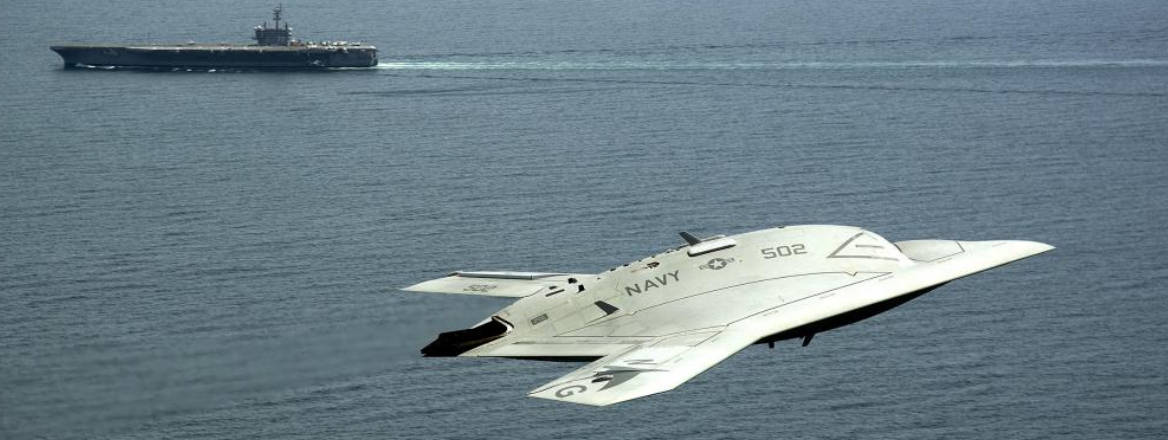US Navy’s Unmanned Warfare Systems Office Went Swimmingly
The deputy commander of the US Navy, Admiral Bill Moran, has announced that its thinking on unmanned systems had changed. The systems now no longer needed their own separate office and its areas of interest and responsibilities would now be absorbed within existing structures. It’s the American way.
The US Navy has made rapid progress with unmanned systems, experimenting, developing and conceptualising how it foresees their use on, above and below the sea.
The naval office of Unmanned Warfare Systems in the Pentagon – closed this week – has posed difficult problems, met challenges and rethought how tools might be used. It has witnessed radical departures from conventional thinking on roles and functions performed in this domain.
The changing role of the carrier-launched X-47B unmanned combat vehicle from combat to refuelling is a good example of this.
In addition, the bureau sponsored work on UpWard Falling Platforms – deep-sea resources from remote command centres that can be recalled to the surface when needed. In other words, they would ‘fall upward’ (by the Defence Advanced Research Projects Agency, DARPA).
It also sponsored work on unmanned surface submarine hunting platforms, such as ACTUV, also by DARPA.
Rather than building up hype and a new taxonomy, the office should be credited for seeking better ways to use autonomous systems than simple sensor or weapon platforms. This most certainly is not an easy task in a service that promotes more ship-drivers and aviators than system engineers.
Given such successes, it might be surprising to many that the organisation is being closed down after less than two years in operation. The office has not had a failure – although it had a habit of pointing as much to its failures as learning experiences as it did to its successes – that indicates a reason for closing.
Rather, the office simply seems to have achieved what it was designed to do, and resources can now be allocated elsewhere. Quite simply, this is military adaptation and the office had done what it had said on the tin.
The higher echelons of the US Navy have a history of adapting rapidly to changes, even when others believe that new ideas and technology will herald a transformation of military operations.
The dismantling of Joint Forces Command (JFCOM) in 2014, just two years after its inception, is a good example of this trend across the US military.
JFCOM had achieved its aim and mainstreamed ‘Jointery’ as normal business. The US Navy has just performed the same feat with their Unmanned Warfare Systems in the Pentagon.
Similarly, in 2016, Admiral John Richardson, the US Navy’s Chief of Naval Operations (CNO), dissolved his Strategic Studies Group (SSG), a collection of around two dozen senior serving officers who tackled wicked problems for the CNO as training for future flag rank at the US Naval War College in Rhode Island in 1981.
The CNO decided that the group was no longer applicable to his problems and closed it down.
What might this tell us about organisation adaptation in the greatest navy in the world? Some might argue that altering headquarters structures and organisational thinking should be done in a dynamic fashion – perhaps even faster than in the US.
Others would provide evidence for a stability and consistency that allows partners and allies to link into the right place and to understand functionality.
Changing organisational design is not simply about speeding up learning or altering an organisation but of adapting structures to suit the challenges it faces, whether technological, resource constrained or conceptual.
This means shutting down or closing bases, headquarters and agencies when they have outlived their usefulness or intent.
Just as Jointery in the American military did not stop when JFCOM was dismantled, or thinking end as SSG was dissolved, so experimentation with the demise of the Unmanned Warfare Systems Office will not end.
Few should doubt that the USN is already well advanced in its next iteration of stimulating and mainstreaming the next big idea, but will – quite rightly – fall back on tried and tested structures as the core of its organisational management.
It is hard, in practical terms, to fault such an approach.
WRITTEN BY
Professor Peter Roberts
RUSI Senior Associate Fellow, Military Sciences


